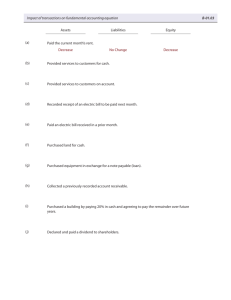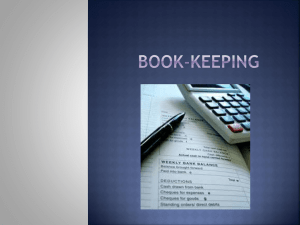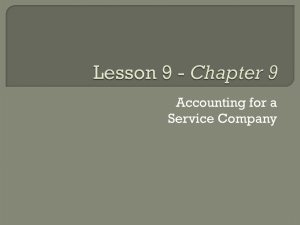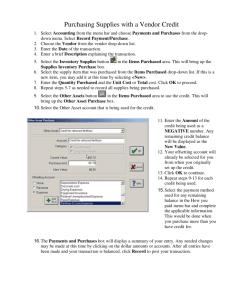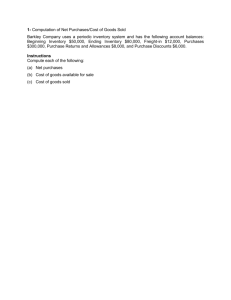Preparation of a Statement of Cash Flows: Direct Method
advertisement
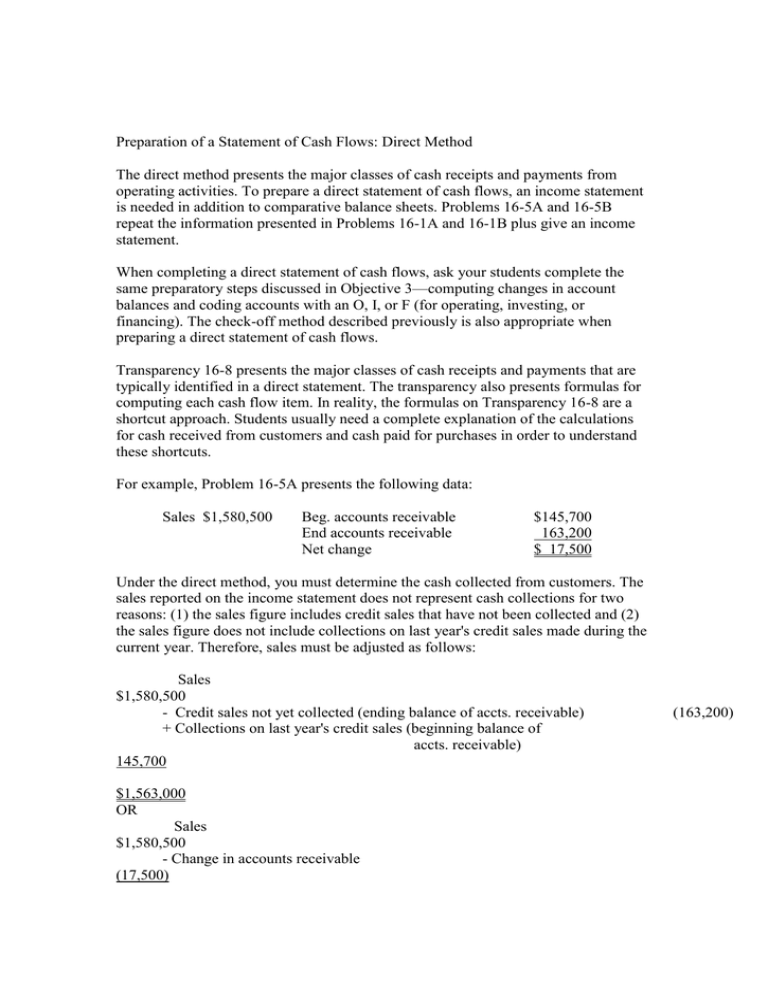
Preparation of a Statement of Cash Flows: Direct Method The direct method presents the major classes of cash receipts and payments from operating activities. To prepare a direct statement of cash flows, an income statement is needed in addition to comparative balance sheets. Problems 16-5A and 16-5B repeat the information presented in Problems 16-1A and 16-1B plus give an income statement. When completing a direct statement of cash flows, ask your students complete the same preparatory steps discussed in Objective 3—computing changes in account balances and coding accounts with an O, I, or F (for operating, investing, or financing). The check-off method described previously is also appropriate when preparing a direct statement of cash flows. Transparency 16-8 presents the major classes of cash receipts and payments that are typically identified in a direct statement. The transparency also presents formulas for computing each cash flow item. In reality, the formulas on Transparency 16-8 are a shortcut approach. Students usually need a complete explanation of the calculations for cash received from customers and cash paid for purchases in order to understand these shortcuts. For example, Problem 16-5A presents the following data: Sales $1,580,500 Beg. accounts receivable End accounts receivable Net change $145,700 163,200 $ 17,500 Under the direct method, you must determine the cash collected from customers. The sales reported on the income statement does not represent cash collections for two reasons: (1) the sales figure includes credit sales that have not been collected and (2) the sales figure does not include collections on last year's credit sales made during the current year. Therefore, sales must be adjusted as follows: Sales $1,580,500 - Credit sales not yet collected (ending balance of accts. receivable) + Collections on last year's credit sales (beginning balance of accts. receivable) 145,700 $1,563,000 OR Sales $1,580,500 - Change in accounts receivable (17,500) (163,200) $1,563,000 Again, discourage your students from trying to memorize rules on whether to add or subtract changes in accounts receivable. Give them a methodology to think through the changes. The methodology presented under Objective 2 will also work in the direct method. The previous calculation could be explained as follows: Accounts receivable increased, so the company is selling more on credit and selling less for cash. Therefore, the effect on cash receipts is negative. OR Accounts receivable increased, indicating that credit sales on account were $17,500 more than cash collections. Therefore, the increase must be subtracted from sales to get cash receipts. Under the direct method, you must also determine the cash paid for purchases. Before you can determine cash paid for purchases, you must know the cost of merchandise purchased. The income statement in Problem 16-5A doesn't show the detailed calculation of cost of merchandise sold; therefore, the cost of merchandise purchased cannot be determined just by looking at the income statement. However, it can be determined as follows: Beginning Inventory + Cost of Merchandise Purchased - Ending Inventory Cost of Goods Sold Therefore, Cost of Goods Sold - Beginning Inventory + Ending Inventory Cost of Merchandise Purchased Using data from Problem 16-5A: Cost of Merchandise Purchased = $957,300 - 367,900 + 395,000 Cost of Merchandise Purchased = $984,400 The cost of merchandise purchased must be adjusted to determine cash payments for purchases, as follows: Cost of merchandise purchased $984,400 - Credit purchases not yet paid for (ending balance of accounts payable) (228,700) + Payments on last year' s credit purchases (beginning balance of accounts payable) 210,500 $966,200 OR (Combining both of these calculations into one formula) Cost of merchandise sold + Change in inventories - Change in account payable Cash payments for purchases $957,300 27,100 (18,200) $966,200 Explain that the increase in inventories can be interpreted as increasing cash payments because more inventory was purchased. The increase in accounts payable can be interpreted as decreasing cash payments because the company made more purchases on account. Continue with the problem, demonstrating the calculations of cash paid for operating expenses and cash paid for income taxes. When you have completed the operating activities section, remind students that the net cash flow is the same number as computed under the indirect method. DEMONSTRATION PROBLEM – Free Cash Flow Free cash flow is the amount of operating cash flows left after paying dividends and paying for assets needed to maintain productive capacity. Free cash flow recognizes that operations must generate sufficient cash to replace assets used in operations. It also recognizes that shareholders want to see companies maintain steady dividend payments. The formula for free cash flow is: - Cash flow from operations Cash used to purchase fixed assets needed to maintain productive capacity Cash used for dividends Free Cash Flow If the calculation of free cash flow yields a negative number, a company’s operations cannot support asset replacement and dividends. Ask your students to review the data given in Problem 16-1A and the completed statement of cash flows (which should be in their notes) to answer the following questions: 1. What is Winner’s Edge cash flow from operating activities for 2006? (Answer: $163,300) 2. What much cash was used to pay dividends in 2006? (Answer: $52,000) 3. What amount of cash was paid to purchase equipment? (Answer: $120,000) 4. Can we assume all of the equipment purchases were to maintain productive capacity? (Answer: No.) Ask your students to assume that 20% of the asset purchases were to maintain productive capacity; the remaining purchases were made to expand operations. Also, ask your students to assume that the purchase of land was made to expand operations. Based on these assumptions, free cash flow would be calculated as follows: Cash flow from operations $163,300 Less: Cash invested in equipment to maintain productive capacity $24,000 Cash used for dividends 52,000 76,000 Free cash flow $ 87,300 Winner’s Edge operations in 2006 did generate sufficient cash flow to pay dividends and maintain productive capacity.
